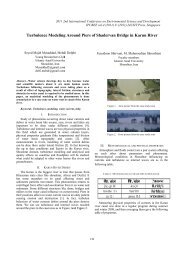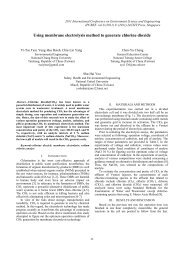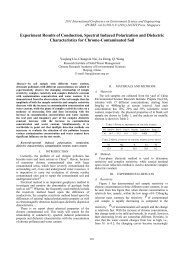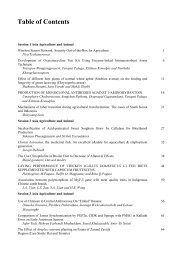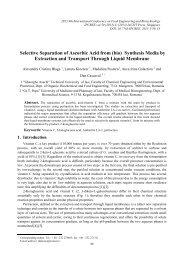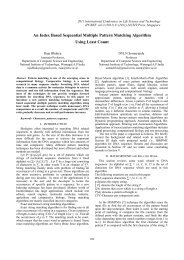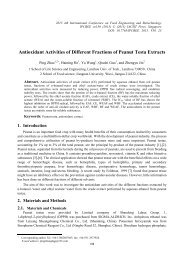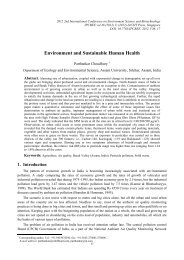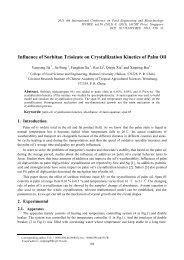Design Analysis of Rotary Tillage Tool Components by ... - ipcbee
Design Analysis of Rotary Tillage Tool Components by ... - ipcbee
Design Analysis of Rotary Tillage Tool Components by ... - ipcbee
You also want an ePaper? Increase the reach of your titles
YUMPU automatically turns print PDFs into web optimized ePapers that Google loves.
2011 International Conference on Environmental and Agriculture Engineering<br />
IPCBEE vol.15(2011) © (2011) IACSIT Press, Singapore<br />
<strong>Design</strong> <strong>Analysis</strong> <strong>of</strong> <strong>Rotary</strong> <strong>Tillage</strong> <strong>Tool</strong> <strong>Components</strong> <strong>by</strong> CAD-tool:<br />
Rotavator<br />
Gopal U.Shinde 1 , J.M.Potekar 2 , R.V.Shinde 3 , Dr.S.R.Kajale 4<br />
1 Assistant Pr<strong>of</strong>essor <strong>of</strong> Mechanical Engg. ,College <strong>of</strong> Agricultural Engineering &Technology<br />
Marathwada Agricultural University, PARBHANI(M.S.)INDIA<br />
2 Associate Pr<strong>of</strong>essor and Head <strong>of</strong> Farm Machinery and Power Department ,College <strong>of</strong> Agricultural<br />
Engineering &Technology,Marathwada Agricultural University, PARBHANI(M.S.)INDIA<br />
3 Assistant Pr<strong>of</strong>essor <strong>of</strong> Physics, College <strong>of</strong> Agricultural Engineering &Technology<br />
Marathwada Agricultural University, PARBHANI(M.S.)INDIA<br />
4 Director& Pr<strong>of</strong>essor <strong>of</strong> Mechanical Engg, Shri. Guru Gobind Singhji Institute <strong>of</strong> Engineering and<br />
Technology, NANDED(M.S.)INDIA<br />
Abstract. The application <strong>of</strong> CAD/CAM in design optimization <strong>of</strong> rotary tillage tool on the basis <strong>of</strong> finite<br />
element method and simulation method is done <strong>by</strong> using CAD-s<strong>of</strong>tware for the structural analysis. The<br />
different tillage tool parts <strong>of</strong> rotary tillage tools are geometrically constrained with preparation <strong>of</strong> solid model<br />
and The Simulation is done with actual field performance rating parameters along with boundary<br />
conditions .The energy constrained for the tillage tool applications with 35Hp and 45Hp power tractor and<br />
estimated forces acting at soil-tool interface. The resultant effect on tillage blade and whole rotavator<br />
assembly is obtained from stress distribution and deformations plots.<br />
The proposed work results in identifying sufficient tolerance in changing the dimensions <strong>of</strong> rotavator frame<br />
sections and side gear box for removing the excess weight in a solid section and also to raise the weight <strong>of</strong><br />
blade for a reliable strength. The present working model with tillage blade is analysed to new design<br />
constraints with change <strong>of</strong> its geometry for the maximum weed removal efficiency <strong>by</strong> presenting its practical<br />
results from the field performance.<br />
Keywords: rotary tillage tool, simulation, FEM, design analysis, stress, deformation, rotavator<br />
1. Introduction<br />
<strong>Rotary</strong> tillage machine which is used in soil-bed preparation and weed control in arable field and fruit<br />
gardening agriculture. It has a huge capacity for cutting, mixing to topsoil preparing the seedbed directly.<br />
And also It has more mixing capacity seven times than a plough. It’s components works under miscellaneous<br />
forces because <strong>of</strong> power, vibration, pointless, impact effect <strong>of</strong> soil parts as after reaching to higher side. The<br />
design optimization and manufacturing errors can be minimized <strong>by</strong> its components design analysis and<br />
optimization. Especially blades and transmission elements have to be reliable in field the performance<br />
against to operating forces. Predicting to stress distributions is so important for the designers, manufacturers<br />
and end user.<br />
The design optimization <strong>of</strong> tillage tool is obtained <strong>by</strong> reducing its weight, cost and <strong>by</strong> improving a field<br />
performance to high weed removal efficiency .The computer aided design analysis <strong>by</strong> preparing a threedimensional<br />
solid modelling and finite elements method applications are getting so widespread in the<br />
industry. Thus due to undesired stress distributions on its componants, it cannot compensate to the operating<br />
forces i.e field environment and results in breakdown and failure due to higher stresses and deformation.<br />
The proposed work develops a computer aided experimental system for design testing and valuation <strong>of</strong><br />
agricultural tools and equipments. The selected physical model <strong>of</strong> rotavator is measured with accurate<br />
1
dimensions and a solid (3-D) model is prepared in CAD-s<strong>of</strong>tware such as Ansys, Catia, Pro-E , hyper mesh<br />
etc. <strong>by</strong> assembling an individual parts with detail specifications.<br />
1.1. Rotavator<br />
<strong>Rotary</strong> tiller is a tillage machine designed for preparing land suitable for sowing seeds (without<br />
overturning <strong>of</strong> the soil), for eradicating weeds, mixing manure or fertilizer into soil, to break up and renovate<br />
pastures for crushing clods etc. It <strong>of</strong>fers an advantage <strong>of</strong> rapid seedbed preparation and reduced draft<br />
compared to conventional tillage. It saved 30-35 % <strong>of</strong> time and 20-25 % in the cost <strong>of</strong> operation as compared<br />
to tillage <strong>by</strong> cultivator. It gave higher quality <strong>of</strong> work (25-30 %) than tillage <strong>by</strong> cultivator. The Rotavator is<br />
the most efficient means <strong>of</strong> transmitting engine power directly to the soil with no wheel slip and a major<br />
reduction in transmission power loss.<br />
The Rotavator will produce a perfect seedbed in fewer passes. It is the ideal implement for cash crop<br />
farmers who need to bury and incorporate crop residues quickly, between crops. <strong>Tillage</strong> tools direct energy<br />
into the soil to cause some desired effect such as cutting, breaking, inversion, or movement <strong>of</strong> soil. Soil is<br />
transferred from an initial condition to a different condition <strong>by</strong> this process (Salokhe et al. 2003).<br />
1.2. Rotavator Assembly consists <strong>of</strong> following parts:<br />
1 . Independent Top Mast: one end <strong>of</strong> shaft will be connected to tractor P.T.O. and another end to<br />
rotavator. Thus it will be used to transmit power from tractor P.T.O. to input rotavator shaft.<br />
2. Single / Multi Speed Gear Box: A gear box with bevel gears, main shaft, pinion shaft, heavy duty<br />
roller bearings combine form a unit to reduce standard P.T.O. rpm 540 rpm to 204 rpm. It enables the rotor<br />
shaft to rotate in the direction <strong>of</strong> travel. This helps in throwing the material behind the rotavator, which<br />
facilities in preventing the clogging <strong>of</strong> rotavator.<br />
3 Chain / Gear Cover Part Flange: A chain and gear cover part flange is a supporting element on<br />
which chain and gears are mounted.<br />
4. Blades: The L shaped will be most common due to L shape is usually superior to others in heavy<br />
trash. They are better for killing weeds. The material composition <strong>of</strong> tine is generally carbon (0.52 %),<br />
manganese (0.72 %), and silicon (1.56 %).<br />
5. Chain / Gear Cover Part: A chain and gear cover part is a covering element in which chain and<br />
gears are safely protected from outside .<br />
6 Frame and Cover: By adjusting the position <strong>of</strong> rear cover; the degree <strong>of</strong> pulverization <strong>of</strong> soil will be<br />
controlled. If the cover will be kept wide open, the clods are thrown away from the rotor. The closed position<br />
<strong>of</strong> cover facilities the clods to get further pulverized <strong>by</strong> the action <strong>of</strong> rotating blades and fine tilth will be<br />
obtained.<br />
7. Adjustable depth skids :It is fixed on adjustable frame to fix up a distance a gap between soil Vs<br />
Blade contact I.e depth skid<br />
8 .Offset adjustable frame: The is fixed rigid support to side parts mounted on rotary blade mounted<br />
shaft.<br />
1.3. CAD model <strong>of</strong> Rotavator:<br />
A solid view <strong>of</strong> CAD-model is prepared with accurate dimensions measured on physical model <strong>of</strong><br />
rotavator as shown in fig1.3 below for the detail analysis<br />
1.4. Finite Element Method:<br />
The following are the three basic features <strong>of</strong> the finite element method.<br />
a) Division <strong>of</strong> whole into parts; which allows representation <strong>of</strong> geometrically complex domains as<br />
collection <strong>of</strong> simple domains that enable a systematic derivation <strong>of</strong> the approximation functions.<br />
b) Derivation <strong>of</strong> approximations functions over each element; the approximation functions are<br />
<strong>of</strong>ten algebraic polynomials that are derived using interpolation theory.<br />
2
fluxes<br />
c) Assembly <strong>of</strong> elements, which is based on continuity <strong>of</strong> the solution and balance <strong>of</strong> internal<br />
1.5. CAD-modeling and analysis:<br />
The three important steps in ANSYS programming used for CAD-modeling and analysis are: a)<br />
Preprocessing b) Solution c) Post processing<br />
After preparing a solid geometry <strong>of</strong> rotavator the important steps are meshing and applying loading and<br />
boundary conditions in the preprocessor so that simulation can be run to get a solution and generate results in<br />
the post-processor<br />
1.6. Mesh Generation (Meshing)<br />
After validation <strong>of</strong> the model next step is generation <strong>of</strong> Finite Element Mesh. For the Rotavator SOLID45<br />
elements are used for meshing. A very fine mesh <strong>of</strong> freedom <strong>of</strong> the model increases Hence a designer has to model<br />
it optimally i.e. placing fine mesh only at critical area; and coarse mesh at other. So that the run time is less and also<br />
the accuracy is not much affected.<br />
1.7. Element Description<br />
1 SOLID 45<br />
The solid meshing using SOLID-45 8 NODE 45 element, DOF: UX, UY, UZ Surface meshing <strong>by</strong><br />
triangular 6 node element<br />
3
1. Element edge length – 1.5 mm for crankshaft. Because in this crankshaft model chamfer width is 3<br />
mm, so for better results. We can take two elements in this area.<br />
2. Element edge length- 2 mm for flywheel and Pulley.<br />
2 BEAM 188<br />
BEAM188 has six or seven degrees <strong>of</strong> freedom at each node using BEAM 188 element DOF: UX, UY,<br />
UZ and rotation RX,RY,RZ The proposed work is taken for complete finite element analysis <strong>of</strong> rotavator<br />
tillage tool which introduces the use <strong>of</strong> CAD analysis for the first time in the design and development <strong>of</strong><br />
Agricultural machine ,tools and equipment.<br />
1.8. OBJECTIVES:<br />
1. To prepare a geometric solid model <strong>of</strong> rotavator <strong>by</strong> using CAD-s<strong>of</strong>tware<br />
2. To make the finite meshing <strong>by</strong> using meshing s<strong>of</strong>tware.<br />
3. To generate a CAD analysis report <strong>of</strong> rotary tillage tool components.<br />
4. To compare existing design and identify the scope in design modifications<br />
2. MATERIALS AND METHODS<br />
2.1. Material:<br />
The materials are taken from the manufacturing database <strong>of</strong> rotavator production system specification<br />
drawn <strong>by</strong> Industry. The Material properties and Soil properties are considered according to following data in<br />
the table2.1<br />
Table 2.1. Material Properties:<br />
Table 2.2. Soil Properties:<br />
2.2. Soil parameters:<br />
The soil properties relevant to the design <strong>of</strong> rotavator were identified as soil type, moisture, bulk density<br />
and cone index. The manners <strong>of</strong> measurement and characterization <strong>of</strong> these properties are discussed in the<br />
following sections. The type <strong>of</strong> soil was black soil were experiment was conducted. Moisture content <strong>of</strong> soil<br />
plays an important role for the growth <strong>of</strong> the crop hence following Soil resistance and Moisture content <strong>of</strong><br />
soil are considered as given in table 2.2.<br />
2.3. Element and Node counts in FE-Model.<br />
Following table shows the total number <strong>of</strong> 2d and 3d elements obtained in FE model <strong>of</strong> rotavator.<br />
2.4. Modal analysis:<br />
The frequencies at which vibration naturally occurs, and the modal shapes which the vibrating system<br />
assumes are properties <strong>of</strong> the system, and can be determined analytically using Modal <strong>Analysis</strong>. The<br />
following table shows an idea about fundamental natural frequencies and higher natural frequencies in Hz.<br />
Section 4.1 contains the deformation plot for individual component and assembly for below mention 10<br />
different natural frequencie<br />
3. RESULT AND CONCLUSION<br />
4
A rotary tillage tool such as Rotavator is designed in computer aided design s<strong>of</strong>tware. The rotary motion<br />
and soil surface interaction is considered with respect to the soil Vs. tillage tool dynamics <strong>by</strong> considering the<br />
following factors effecting the tillage operation such as tractor power (hp), maximum peripheral force (N),<br />
rotavator tyne velocity (m/s), tractor transmission efficiency (0.9 for concurrent revolution and 0.8-0.9 for<br />
reversed rotary), soil resistance to 0.7-0.8, radius <strong>of</strong> rotary (mm)<br />
The design analysis executed<br />
• Maximum Peripheral force on rotary blade 6031.08975 (for35 hp)N and 7041.17 N (for 45hp)<br />
• Torque= 270600 N-mm(for35 hp)N and 315920 N-mm (see appendix-I)<br />
The <strong>Design</strong> analysis <strong>of</strong> rotavator results with an output file generated <strong>by</strong> simulation with respect<br />
yield stress and deformation obtained <strong>by</strong> using field conditions in the Post processor.<br />
Modal analysis<br />
The modal analysis as per above stated condition is done and the results obtained from the table 1 in<br />
Appendix VI, it is observed that<br />
1. The maximum and minimum deformation <strong>of</strong> 1.923mm and 0.252mm respectively was observed in<br />
blade section.<br />
Structural analysis<br />
The structural analysis as per above stated condition is done and the results obtained from the table 2<br />
in Appendix VI, it is observed that<br />
1. The displacement Vector Sum and Von Misses Stress is maximum at blade<br />
-section such as 6.757 mm and 417.03 Mpa respectively for 35 hp tractor<br />
2. The displacement Vector Sum and Von Misses Stress is maximum at blade<br />
- section such as 7.893 mm and 503.21 Mpa respectively for 45 hp tractor<br />
Blade analysis<br />
1. The maximum Displacement vector sum in: 6.757mm ( 35 hp) and 7.893 mm(45 hp )<br />
2. The maximum Von Misses Stress: 417.03 Mpa( 35 hp) and 503.20 Mpa (45 hp)<br />
3. The maximum principle stress for 35 hp tractor is 490 Mpa was observed in blade section. This<br />
stress value is less than yield stress <strong>of</strong> blade material i.e 690 Mpa<br />
4. The maximum principle stress for 45 hp tractor is 577 Mpa was observed in blade section. This<br />
stress value is less than yield stress <strong>of</strong> blade material i.e 690 Mpa<br />
to<br />
4. REFERENCES<br />
[1] Akinci, I., D. Yilmaz, and M. Canakci. (2005). Failure <strong>of</strong> a <strong>Rotary</strong> Tiller Spur Gear. Engineering failure<br />
5
[2] analysis, 12(3): 400- 404.<br />
[3] Altair Engineering. Inc, “Hypermesh Users Guide”, 2003<br />
[4] Anonymous, (1971). <strong>Design</strong> data book. PSG college <strong>of</strong> Tech. Kalaikathir Publications, Coimbatore.<br />
[5] Ansys Inc, “ANSYS 8.1 Documentation, Structural <strong>Analysis</strong> Guide”, Swansos <strong>Analysis</strong> System, United state,<br />
2004<br />
[6] Bechly, M. E., and P. D. Clausent. (1997). “Structural <strong>Design</strong> <strong>of</strong> a Composite wind turbine blade using Finite<br />
Element <strong>Analysis</strong>”. Computers & Structures Vol. 63. No. 3, pp. 639-616.<br />
[7] Beeny, J.M., and D. C. Khoo. (1970). “Preliminary investigations in to the performance <strong>of</strong> different shaped blades<br />
for the rotary tillage <strong>of</strong> wet rice soil”. J. Agric. Engg. Res, 15 (1):27-33.<br />
[8] Ben Yahia, Logue, and M. Khelifi. (1999). “Optimum settings for rotary tools used for on-the-row mechanical<br />
cultivation in corn”. Transactions <strong>of</strong> ASAE, 15(6): 615-619.<br />
[9] David Roylance (2001). “Finite Element <strong>Analysis</strong> Method”. Department <strong>of</strong> Materials Science and Engineering<br />
Massachusetts Institute <strong>of</strong> Technology Cambridge, MA 02139 February 28<br />
[10] Fielke, J.M, T.W. Reiley; M.G. Slattery and R.W. Fitzpatt. (1993). “Comparision <strong>of</strong> tillage forces and wear rates<br />
<strong>of</strong> pressed and cast cultivator shares”. Soil and <strong>Tillage</strong> Research, 25; 317-328.<br />
[11] Ghosh, B.N. (1967). “The power requirement <strong>of</strong> a rotary cultivator”. J. Agric. Engg. Res., 12 (1): 5-12.<br />
[12] Gill, W.R., and G.E. Vanden Berg. (1996). “<strong>Design</strong> <strong>of</strong> tillage tool. In soil dynamics in tillage and traction”. 211-<br />
294. Washington, D.C.,U.S.GPO<br />
6





